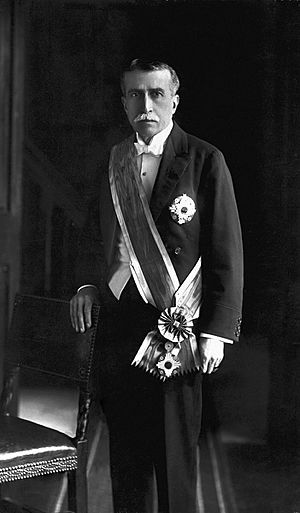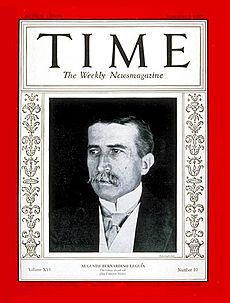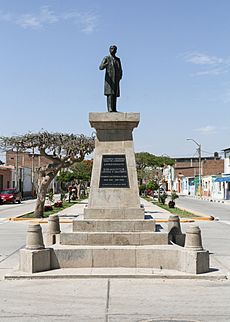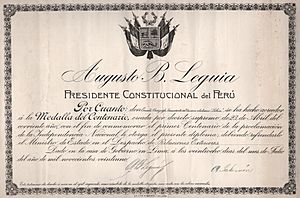Augusto B. Leguía facts for kids
Quick facts for kids
Augusto B. Leguía
|
|
|---|---|
 |
|
| 40th President of Peru | |
| In office 12 October 1919 – 25 August 1930 |
|
| Prime Minister | Melitón Porras Osores German Leguía y Martínez Julio Ego-Aguirre Dong Alejandro Maguiña Pedro José Rada y Gamio Benjamín Huamán de los Heros Fernando Sarmiento Ramírez |
| Vice President | César Canevaro Agustín de la Torre González |
| Preceded by | Augusto B. Leguía (Provisional President) |
| Succeeded by | Manuel Ponce (Military Junta) |
| 36th President of Peru | |
| In office 24 September 1908 – 24 September 1912 |
|
| Prime Minister | Eulogio I. Romero Salcedo Rafael Fernández de Villanueva Javier Prado y Ugarteche Germán Schreiber Waddington José Salvador Cavero Ovalle Enrique C. Basadre Stevenson Agustín Ganoza y Cavero |
| Vice President | Eugenio Larrabure y Unanue Belisario Sosa |
| Preceded by | José Pardo |
| Succeeded by | Guillermo Billinghurst |
| Provisional President of Peru Coup d'état |
|
| In office 4 July 1919 – 12 October 1919 |
|
| Prime Minister | Mariano Cornejo Zenteno Melitón Porras Osores |
| Preceded by | José Pardo y Barreda (Constitutional President) |
| Succeeded by | Augusto B. Leguía (Constitutional President) |
| Prime Minister of Peru | |
| In office September 24, 1904 – August 1, 1907 |
|
| President | José Pardo y Barreda |
| Preceded by | Alberto Elmore Fernández de Córdoba |
| Succeeded by | Agustín Tovar Aguilar |
| Minister of Finance and Commerce | |
| In office September 8, 1903 – August 1, 1907 |
|
| President | Manuel Candamo Serapio Calderón José Pardo y Barreda |
| Prime Minister | José Pardo y Barreda Alberto Elmore Fernández de Córdoba Augusto B. Leguía |
| Preceded by | Pablo Sarria |
| Succeeded by | Germán Schreiber Waddington |
| Personal details | |
| Born |
Augusto Bernardino Leguía y Salcedo
February 19, 1863 Lambayeque, Peru |
| Died | February 6, 1932 (aged 68) Callao, Peru |
| Political party | Civilista Party (until 1920) Reformist Democratic Party (1920-1932) |
| Profession | Economist |
Augusto Bernardino Leguía y Salcedo (born February 19, 1863 – died February 6, 1932) was a Peruvian politician. He served as President of Peru two times. His first term was from 1908 to 1912. His second term was from 1919 to 1930. This second period is known as El Oncenio de Leguía, which means "Leguía's Eleven-Year Rule."
Contents
Early Life and Career
Augusto Leguía was born in Lambayeque in 1863. He later married into an important Peruvian family. He studied in Valparaíso, Chile. During the War of the Pacific (1879–1881), he served in the Peruvian Army.
After the war, he moved to the United States. There, he became a successful insurance executive. By the early 1900s, Leguía had become very rich. He decided to return to Peru and enter politics. In 1903, he became the Minister of Finance. He held this job until 1904. Then, he became Prime Minister until 1907. After that, he decided to run for president.
First Time as President

In 1908, Augusto Leguía was elected president for the first time. He took office after José Pardo. One of Leguía's first goals was to make Peru more modern. He wanted to improve the economy and industry.
On May 29, 1909, a group of people tried to force Leguía to resign. They broke into the government palace. They even kidnapped him and took him to a public monument. But Leguía refused to give up his position. The police had to rescue him, and there was a fight.
During this time, Peru also had disagreements about its borders with five neighboring countries. Leguía was able to make agreements with two of them: Bolivia and Brazil.
- The border with Brazil was set by the Treaty of Velarde-Río Branco. This treaty used two rivers, the Yaravi and Yaverija, as most of the border.
- With Bolivia, the Treaty of Polo-Bustamante divided Lake Titicaca. It also clearly defined the border between Peru and Bolivia.
Leguía's first term ended in 1912. He was followed by Guillermo Billinghurst, a rich businessman. In the years after his first presidency, Leguía traveled. He visited the United Kingdom and the United States. He learned about banking and finance. He later used this knowledge in Peru. During this time, he also left the Civilista Party.
Second Time as President
In 1919, Leguía ran for president again. He was worried that the current government would not accept his victory. So, he led a successful military takeover. This made him the temporary president. He then closed Congress. A new parliament was elected, and they chose him as the official president of Peru.
Leguía changed the Peruvian constitution in 1920. The new constitution was more open and allowed the president to be re-elected many times. However, Leguía often did not follow this new constitution himself.
His years in power were marked by a very strong style of rule. He stopped all opposition harshly. Even though he came from a powerful group, this group turned against him when he took power. His loyal supporters helped him stay in charge.
Many people who disagreed with his government were sent away from Peru. One important person was Víctor Raúl Haya de la Torre. While he was away in Mexico, he started a political group called the American Popular Revolutionary Alliance (APRA) in 1924. This group became very active in Peru. Another key political figure of this time was José Carlos Mariátegui.
During Leguía's second term, many good things happened. He started a plan to make Lima more modern. This included public works projects, like building hospitals and improving drainage systems. The Government Palace was also updated in 1926. New banks were also created, such as the Banco Central de Reserva del Perú.
Agreements about borders were also signed with Colombia and Chile:
- The border with Colombia was settled with the Treaty of Salomón-Lozano in 1922. This treaty gave Peru some land between the Putumayo and Caquetá rivers.
- The Tacna–Arica compromise was signed with Chile. This agreement was criticized later because it led to economic problems.
Overthrow and Final Years

The Great Depression was a time when the world economy was very bad. This meant less money came into Peru from other countries. After eleven years in power, Leguía's government was overthrown. This happened on August 22, 1930. The takeover was led by Luis Miguel Sánchez Cerro in Arequipa.
Leguía was arrested. He was accused of misusing government money. He was kept in prison in Lima. He died in a naval hospital on February 6, 1932.
Images for kids
See also
 In Spanish: Augusto Leguía para niños
In Spanish: Augusto Leguía para niños



